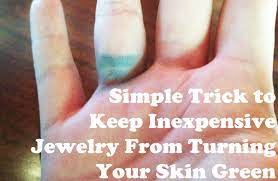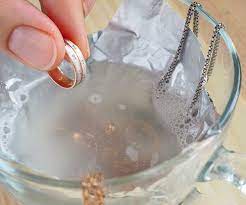
5 DIY Solutions To Get Green Off Skin From Fake Jewelry
- Roger
- 0
- on Nov 23, 2022
5 DIY Solutions To Get Green Off Skin From Fake Jewelry
If you’ve ever found yourself with a green finger after wearing fake jewelry, you’re not alone. It’s a common problem that can be caused by a number of different factors, including the metal in the jewelry, the type of paint used, and even the pH level of your skin.
Luckily, there are a few DIY solutions that can help get rid of the green quickly and easily. Here are 5 of our favorites:
1. Soak in warm water: This is one of the easiest and quickest ways to get rid of green fingers. Simply soak your hands in warm water for a few minutes and then scrub with a soft brush or cloth.
2. Use lemon juice: Lemon juice is another great option for getting rid of green fingers. Simply apply some lemon juice to a cotton ball and rub it onto your skin. You can also try soaking your hands in lemon juice for a few minutes before rinsing off with warm water.
3. Try white vinegar: If you have white vinegar on hand, you can use it to get rid of green fingers as well. Simply soak your hands in white vinegar for a few minutes before rinsing off with warm water. You can also try applying white vinegar to a cotton ball and rubbing it onto your skin.
4. Rubbing alcohol: Rubbing alcohol is another household item that can be used to get rid of green fingers from fake jewelry. Simply soak your hands in rubbing alcohol for
how to tell if vintage jewelry is valuable
When it comes to vintage jewelry, there are a few key indicators that can help you determine if the piece is valuable. First, look at the overall condition of the piece. Is it in good condition with minimal wear and tear? If so, it’s likely to be more valuable than a piece that is heavily damaged or shows significant signs of wear. Next, take a look at any markings on the piece. If it’s signed by a well-known designer or maker, it’s likely to be more valuable than an unsigned piece. Finally, research the piece to see if it has any historical significance. A piece with a strong connection to a famous event or person is likely to be more valuable than a similar piece without that connection.
How to inspect vintage jewelry for value
To properly inspect vintage jewelry for value, you will need a few supplies. First, you will need a good magnifying glass. This will allow you to closely examine the piece for any damage or wear. Next, you will need a soft, lint-free cloth. This is to wipe away any dirt or grime that may be obscuring your view. Finally, you will need a strong light source. A desk lamp with an adjustable arm is ideal.
With your supplies gathered, begin by taking a close look at the piece under good lighting conditions. Examine it for any chips, cracks, or other damage. Also look for signs of wear, such as scratches or tarnish. These factors can significantly affect the value of vintage jewelry. If the piece appears to be in good condition overall, proceed to the next step.
Using your soft cloth, gently wipe away any surface dirt or grime from the jewelry piece. Be careful not to use too much pressure, as you could damage delicate areas such as filigree work or enameled sections. Once the piece is clean, take another close look at it under magnification and strong light conditions to make sure you haven’t missed anything important.
The difference between fake and real vintage jewelry
is the quality of the materials. Fake vintage jewelry is usually made with lower quality materials that will not last as long. This is why it is important to do your research before buying vintage jewelry. There are a few things you can look for that will help you determine if a piece is real or fake. First, check the weight of the piece. Real vintage jewelry is usually heavier than fake pieces because they are made with higher quality materials. Second, look at the construction of the piece. Vintage jewelry is typically well-made and has intricate details that fake pieces lack. Finally, examine the finish of the piece. Vintage jewelry should have a smooth, even finish, while fake pieces often have an uneven or dull finish. By taking these factors into consideration, you can be sure to find genuine vintage jewelry that will stand the test of time.
How to care for vintage jewelry
Vintage jewelry is a classic and timeless accessory that can add a touch of elegance to any outfit. While it is important to take care of all your jewelry, vintage pieces require special care in order to maintain their condition and value. Here are some tips on how to properly care for vintage jewelry:
1. Store your vintage jewelry in a cool, dry place away from direct sunlight or intense artificial light. This will help prevent the colors from fading or the metal from tarnishing.
2. Avoid wearing your vintage jewelry while doing activities that could damage it, such as gardening, cleaning, or cooking.
3. Clean your vintage jewelry regularly with a soft cloth and mild soap-and-water solution. Be sure to rinse well and dry completely before storing.
4. Take extra care when putting on and removing chains, as they are often delicate and can easily become tangled or broken.
5. Have your vintage jewelry checked by a professional jeweler every few years to ensure that it is still in good condition and fix any loose stones or damaged settings
how to retrieve jewelry from bathroom sink
When it comes to removing green discoloration from your skin caused by fake jewelry, there are a few different approaches you can take. Some may require a trip to the store for supplies, while others may use items you already have around the house.
One simple solution is to mix equal parts vinegar and water in a bowl. Submerge the affected area in the mixture for about 15 minutes, then rinse with warm water. You can also try using lemon juice instead of vinegar.
If you have baking soda on hand, you can make a paste by mixing it with water. Apply the paste to the affected area and let it sit for 15 minutes before rinsing with warm water.
To make a stronger cleaning solution, mix 1 part dish soap with 2 parts hydrogen peroxide. Apply this to the affected area and let it sit for 5-10 minutes before rinsing with warm water. Be sure to test this on a small patch of skin first to ensure you don’t have an allergic reaction.
If you want to purchase a product specifically designed to remove fake tanner or green discoloration from your skin, look for one that contains exfoliating beads or AHAs (alpha hydroxy acids). These ingredients will help to slough away dead skin cells, revealing fresh, new skin underneath.